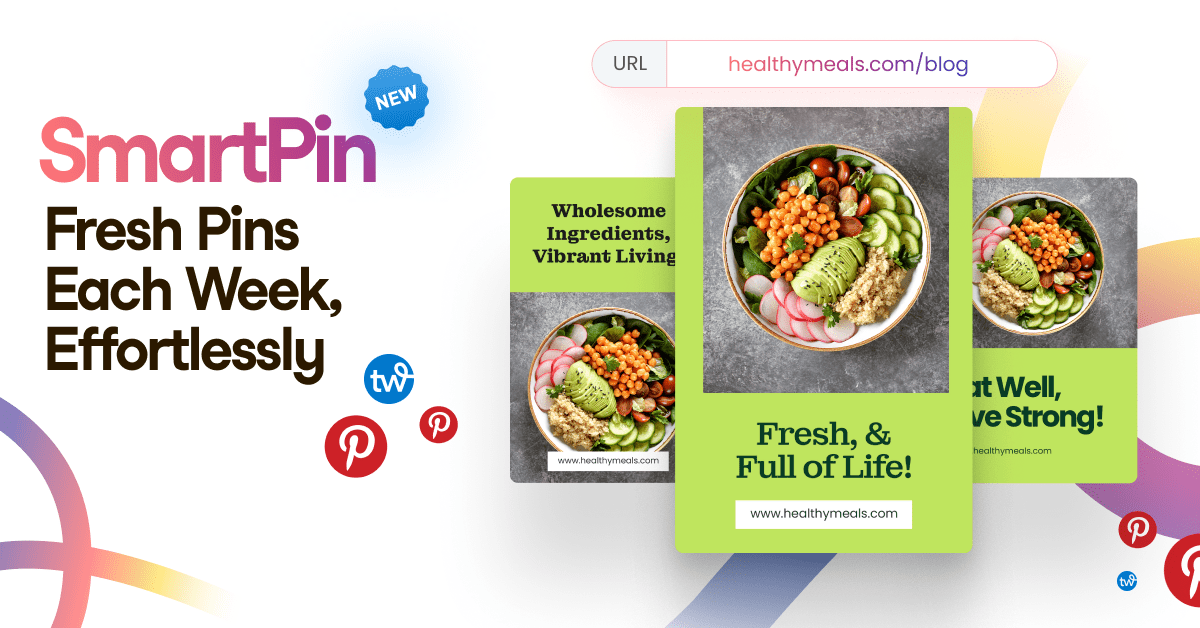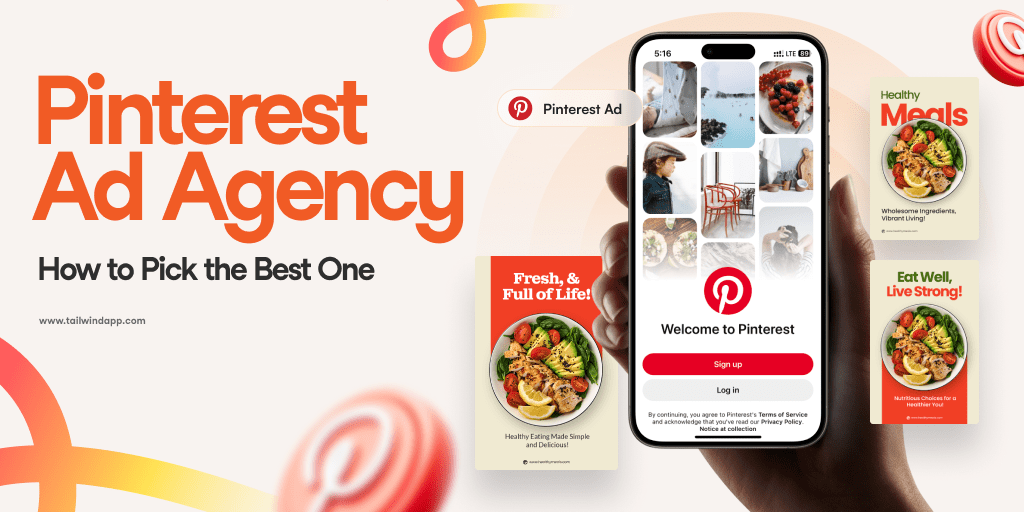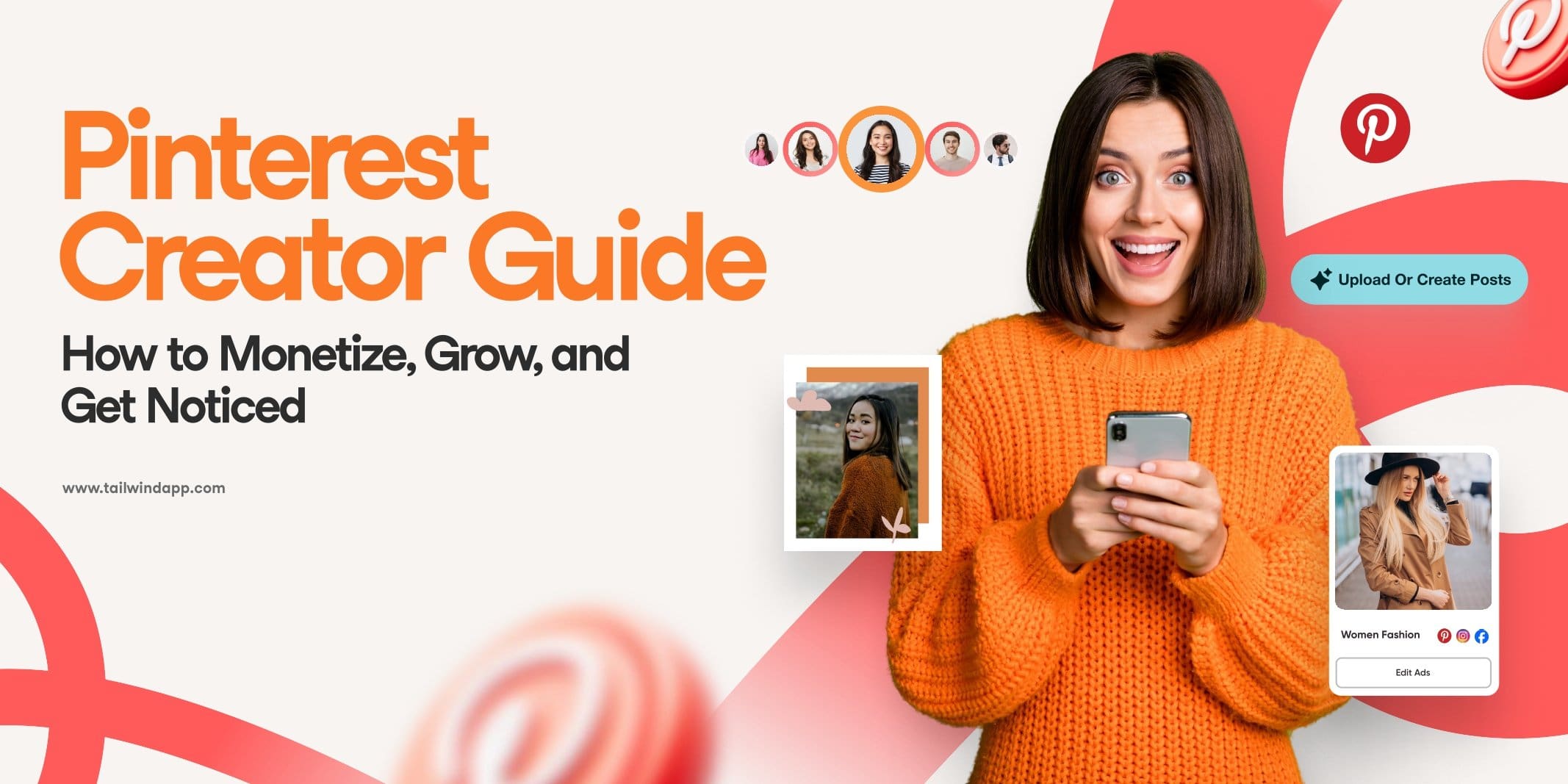
Are you struggling to gain traction on Pinterest despite creating beautiful Pins and sharing valuable content? The problem might not be your content — it could be your profile.
With over 450 million monthly active users and 89% of them using the platform for purchase inspiration, Pinterest isn’t just another social media platform — it’s a visual search engine with incredible potential for driving traffic and sales.
But here’s the thing: even the most gorgeous Pins won’t perform well if they’re coming from an unoptimized profile.
In this comprehensive guide we’ll walk you through a 11-step Pinterest profile checklist that will transform your account from overlooked to overperforming.
Whether you’re a blogger, small business owner, or content creator, implementing these strategies will help you build a foundation for Pinterest success in 2025.
Let’s dive in!
Section 1: Setting Up Your Pinterest Foundation
1. Choose the Right Account Type
The very first step in your Pinterest journey is ensuring you have the right type of account. While personal accounts are fine for casual pinning, a business account is essential if you’re using Pinterest for professional purposes.
Benefits of a business account include:
- Pinterest Analytics: Access detailed insights about your audience and Pin performance
- Rich Pins: Display additional information directly on your Pins
- Ad capabilities: Run promoted Pins to expand your reach
- Brand presence: Present yourself professionally to potential followers
PRO TIP:
Even if you’re a solopreneur or creator, a business account gives you powerful tools that a personal account doesn’t offer — at no additional cost.

2. Complete Your Profile Information
Your profile information is prime real estate for keywords and branding. Here’s how to optimize each element:
Username:
- Keep it consistent with your brand name across platforms
- Make it easy to spell and remember
- Avoid numbers or special characters unless part of your brand
- Aim for 20 characters or less
Display Name:
- Include your brand name plus 1-2 keywords that describe what you do
- Example: “Healthy Baking Co | Gluten-Free Recipes”
- Limit to 65 characters for optimal display
Bio:
- Write a clear, keyword-rich description of what you offer
- Include your unique value proposition
- Add a call-to-action (what should visitors do next?)
- Use relevant keywords naturally
- Limit to 160 characters
Here’s a winning formula for your bio:
I help [target audience] with [your specialty] to [benefit]. [Call to action].
Example: I help busy moms create quick, healthy meals their kids will actually eat. Grab my free meal planning template!
Website URL:
- Add your website and verify it to enable Rich Pins
- If you don’t have a website, consider linking to another platform where you’re active
3. Upload an On-Brand Profile Picture
Your profile picture creates your first impression on Pinterest. Make it count!
Technical specifications:
- Optimal size: 165 x 165 pixels
- Circular crop display (upload a square that looks good when cropped to a circle)
- High-resolution image (no blurry photos!)
For businesses and brands:
- Use your logo for instant brand recognition
- Keep it simple — small details won’t be visible at thumbnail size
- Ensure high contrast for visibility
For personal brands:
- Use a professional headshot with good lighting
- Show your face clearly (no sunglasses or distant shots)
- Match the tone of your brand (professional, approachable, creative, etc.)
Remember, your profile picture appears quite small in the Pinterest interface, so simplicity wins over complexity.
4. Create a Compelling Cover Image
Pinterest now offers a cover feature that displays at the top of your profile. This is valuable visual real estate for showcasing what you’re all about!
Technical specifications:
- Recommended dimensions: 800 x 450 pixels
- Maximum file size: 10MB
- PNG or JPG format
Strategic cover ideas:
- Showcase your best products in a collage
- Display a lifestyle image that represents your brand aesthetic
- Include your tagline or value proposition as text overlay
- Feature seasonal offerings or current promotions
- Showcase yourself in action (if you’re a personal brand)
Best practices:
- Update your cover image seasonally to keep your profile fresh
- Ensure any text is large enough to read on mobile devices
- Maintain your brand color palette for consistency
- Don’t overcrowd — keep it clean and impactful
Section 2: Optimizing Your Pinterest Boards
5. Strategic Board Creation
Your boards are essentially categories that help users navigate your content. Creating strategic, well-organized boards is crucial for discovery.
How many boards should you have?
- Start with 8-10 core topic boards
- Expand gradually based on your content creation
- Quality over quantity: each board should have a clear purpose
Board strategy:
- Create boards that align with your business goals and audience interests
- Use a mix of broad and specific topics
- Think about your customer journey and create boards for each stage
- Research competitors to identify popular board topics in your niche
Public vs. private boards:
- Make customer-facing, SEO-optimized boards public
- Keep boards private if they’re:
- Personal inspiration unrelated to your brand
- Works in progress
- Competitor research
- Planning boards
Remember to reorder your boards regularly, keeping your most important and active boards at the top of your profile.
6. Board SEO Optimization
Each board is an opportunity to rank for keywords. Here’s how to optimize them:
Board titles:
- Use specific, searchable keywords
- Be clear rather than clever
- Front-load the most important keywords
- Avoid special characters that might confuse the algorithm
- Keep titles under 50 characters for better display
Board descriptions:
- Write 1-2 sentences describing the board content
- Include 3-5 relevant keywords naturally
- Add a call-to-action when relevant
- Use proper punctuation and grammar
Example of an optimized board:
- Title: “Healthy Breakfast Recipes | Quick & Easy”
- Description: “Delicious, nutritious breakfast recipes ready in under 15 minutes. Perfect for busy mornings! Find egg recipes, smoothie bowls, overnight oats, and protein-packed options.”
Board categorization:
- Select the most relevant category from Pinterest’s options
- This helps Pinterest understand your content for search results
7. Board Cover Selection
Board covers create visual organization and branding across your profile. The extra effort here makes your profile look professional and curated.
Cover creation options:
- Select an existing Pin from your board
- Create custom board covers with your brand elements
For custom covers:
- Maintain consistent design elements across all boards
- Use templates with your brand colors and fonts
- Include the board name on the cover image
- Keep designs simple and recognizable at small sizes
- Recommended size: 800 x 800 pixels (displays at various sizes)
PRO TIP:
Create board covers in batches using design tools like Canva, which offers Pinterest board cover templates.
8. Board Organization
The arrangement of your boards matters for user experience and conversion.
Strategic board arrangement:
- Place your most important boards in the top row
- Group related boards together
- Showcase seasonal content temporarily at the top
- Consider the visual flow of colors and images across boards
Board sections:
- Use sections to organize extensive boards into subcategories. Example: Your “Healthy Recipes” board could have sections for breakfast, lunch, dinner, and snacks.
- Add 5-10 Pins to each section to get started
- Name sections with keyword-rich, clear titles
Regular maintenance:
- Archive boards that are no longer relevant to your brand
- Combine boards with too few Pins
- Delete or make private any boards that don’t support your business objectives
- Aim to review and refresh your board organization quarterly
Section 3: Pin Creation and Optimization
9. Pin Design Best Practices
Your Pins are the primary way users discover your content. Follow these design best practices for maximum impact:
Pin dimensions:
- Optimal ratio: 2:3 (width:height)
- Recommended size: 1000 x 1500 pixels
- Minimum width: 600 pixels
- Maximum length: 2100 pixels (longer Pins get cut off)
Design elements that drive clicks:
- Bold, easy-to-read text overlay
- High-quality, relevant images
- Clear branding (logo or website name)
- Contrasting colors that stand out in the feed
- Whitespace to prevent visual overload
Color psychology:
- Red and orange can create urgency
- Blue establishes trust
- Green works well for health, wellness, and finance
- Test different color schemes to see what your audience responds to
Text guidelines:
- Use no more than 1-2 fonts per Pin
- Include a clear headline that promises a benefit
- Keep text concise (3-5 words in headline, 1-2 supporting phrases)
- Ensure text is legible on mobile (min. 30pt font)
- Balance text and imagery (60% image, 40% text is a good rule)
10. Pin SEO and Description
The invisible elements of your Pins are just as important as the visual aspects:
Pin titles:
- Include your primary keyword at the beginning
- Keep titles under 100 characters
- Be specific about what users will find when they click
- Use power words that trigger emotion or action
Pin descriptions:
- Write 1-2 sentences (150-300 characters)
- Include 3-5 relevant keywords
- Add a clear call-to-action
- Use conversational, natural language
- Include relevant hashtags (3-5 maximum)
Hashtag strategy:
- Use broad, medium, and niche-specific hashtags
- Research trending hashtags in your industry
- Create a branded hashtag for your content
- Don’t overuse hashtags — quality over quantity
Example of optimized Pin title, description, and hashtags:
“15-Minute Healthy Breakfast Ideas for Busy Mornings”
“Start your day right with these quick, protein-packed breakfast recipes perfect for busy weekdays. These simple meals take just 15 minutes and will keep you full until lunch! #healthybreakfast #quickrecipes #morningroutine”
11. Link Destination Optimization
The user experience after clicking your Pin is crucial for Pinterest success:
Landing page quality factors:
- Content must deliver what the Pin promised
- Page should load in under 3 seconds
- Clear navigation and next steps for visitors
- Minimal pop-ups and distractions
Mobile optimization requirements:
- Responsive design that works on all devices
- Tap targets (buttons, links) large enough for fingers
- Readable text without zooming
- No horizontal scrolling required
Content relevance:
- The landing page must contain the information or product shown in the Pin
- Include the keywords from your Pin in your page content
- Provide value immediately (answer the question or solve the problem)
- Include relevant internal links to keep visitors on your site
PRO TIP:
Pinterest checks your destination URL for quality and relevance. Broken links or misleading content can hurt your overall Pinterest performance.
Pinterest Profile Audit Checklist
To maintain a high-performing Pinterest profile, regular audits are essential. Use this checklist for monthly, quarterly, and annual reviews.
Monthly Profile Audit
General Profile:
- [ ] Update seasonal board covers if applicable
- [ ] Check profile analytics for growth and engagement
- [ ] Review and refine board order based on performance
- [ ] Ensure all links are working properly
- [ ] Verify that your website is still claimed
Content Performance:
- [ ] Identify top-performing Pins and create similar content
- [ ] Review and update underperforming Pin descriptions
- [ ] Check that all Pins link to valid destinations
- [ ] Assess keyword performance and update strategy as needed
Quarterly Clean-Up Tasks:
Board Organization:
- [ ] Archive seasonal boards that are no longer relevant
- [ ] Combine low-volume boards when appropriate
- [ ] Add sections to boards with more than 50 Pins
- [ ] Delete duplicate Pins
Visual Cohesion:
- [ ] Ensure consistent branding across new Pins
- [ ] Update board covers for visual consistency
- [ ] Review profile picture and cover image for relevance
- [ ] Check that your most recent Pins reflect your current brand style
Annual Strategy Review:
Account Assessment:
- [ ] Review overall account growth against goals
- [ ] Analyze which boards and Pin types drove the most traffic
- [ ] Evaluate conversion rates from Pinterest traffic
- [ ] Identify new keyword opportunities based on trends
Content Planning:
- [ ] Develop a content calendar for the upcoming year
- [ ] Plan seasonal content in advance
- [ ] Identify content gaps based on audience needs
- [ ] Set specific, measurable goals for the next year
Conclusion
An optimized Pinterest profile is the foundation for all your Pinterest marketing success. By following this 11-step checklist, you’ll create a professional, searchable, and engaging presence that attracts your ideal audience.
Remember that Pinterest is a long-game platform — Pins can continue driving traffic for months or even years after publishing. This makes your initial setup investment incredibly valuable over time.
Start with the fundamentals: convert to a business account, complete your profile with keywords, and create strategic boards. Then move to the more advanced tactics like Pin optimization and regular audits. Even implementing just a few of these steps will put you ahead of many Pinterest users.
What part of your Pinterest profile will you optimize first? Share your Pinterest handle in the comments, and let’s connect!
Frequently Asked Questions
How often should I update my Pinterest profile?
Your core profile elements (picture, name, bio) should be updated whenever your brand evolves or you pivot your focus. Board covers should be refreshed quarterly or seasonally. Your overall board organization should be reviewed at least twice a year to ensure it still represents your content strategy.
Is a business account really necessary for small creators?
Yes, absolutely. Even if you’re just starting out, a business account gives you access to analytics, Rich Pins, and advertising capabilities at no cost. These tools are invaluable for understanding what’s working and growing your presence strategically.
How many Pins should I create per blog post?
Create 3-5 different Pin designs for each piece of content to test which style resonates best with your audience. This allows you to target different keywords and visual preferences while driving traffic to the same content.
Do I need to be on Pinterest daily for the algorithm to favor me?
No, consistency matters more than frequency. It’s better to pin 3-5 times per week consistently than to pin 20 times one day and then disappear for a month. The Pinterest algorithm rewards consistent activity over sporadic bursts.




